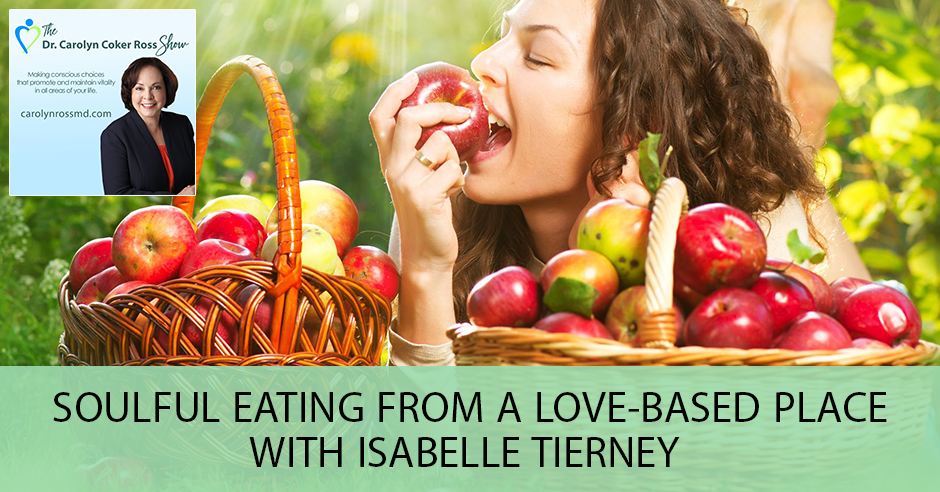
In order to become what the society dictates us to become, we tend to deprive ourselves with a lot of things. In terms of our body, we starve ourselves in order to look the ideal way. We don’t eat from a place of love. Instead, we eat from a place of fear. Isabelle Tierney teaches soulful eating, which is when you choose to eat to nourish your body from a love-based place. She is a life coach and licensed marriage and family therapist with an M.A. from Tufts University in Child Development. She is the founder of the Body Beloved Renaissance, a counter-cultural movement designed to shift us from shaming our bodies to seeing them as sacred. Shifting from that place of fear and deprivation, Isabelle explains the concept of soulful eating versus emotional eating, eating to feed the soul rather than the emotion.
—
Listen to the podcast here:
Soulful Eating From A Love-Based Place with Isabelle Tierney
My guest is Isabelle Tierney. We’re going to be talking about from emotional eating to soul-full eating. She’s a licensed marriage and family therapist who holds an MA from Tufts University in Child Development, a certificate in Play Therapy, a certificate in the Brennan Energy Healing Science and an MA from Boston University in International Relations and Communications. She’s been in private practice internationally since 1996, specializing in eating disorders and other painful eating habits. She’s also a certified yoga teacher and incorporates yogic principles to help clients reenter their bodies and discover the freedom and joy that lives there. Welcome to the show, Isabelle. It’s a pleasure to have you.
Thank you, Carolyn. I’m excited to be on.
You’re in the process of writing a book about this concept of emotional eating versus soul-full eating. I wanted to talk a little bit about what you mean by soul-full eating. Can you tell us a little bit more about what that is?
Soul-full eating is one in which you choose to eat to nourish your body, to be in a relationship with your body from a love-based placed. As you know with the work you do, most of us don’t eat from a place of love. We eat from a place of fear. We eat from a place of hard rules. We eat from a place of deprivation. Food in a sense in much of our society has become a scary poison. Nobody knows what the heck to eat anymore. Soul-full eating is about finding a way to eat and to nourish your body and to be in a relationship with your body that uses love, gratitude, reverence and kindness. These are all what I call soul qualities. How can we shift from a place of fear and deprivation-eating and relationship with our body to a place where we eat and nourish our bodies with gratitude, with awe, with reverence and with joy? It completely changes the way we nourish ourselves. I got tired in my own personal life of living in a way that was painful and deprivational that I started moving toward making it a soul-based way.
Soul-full eating is feeding the soul instead of feeding the emotions or trying to hide the emotions with food. Is that the concept?
Those of us who struggle with eating issues, we have a hard time being full. There’s such a longing to be filled with soul. We don’t know how to do it. Nobody’s taught how to do it. What we do is we’ll fill ourselves with food instead. I believe that those of us who struggle with overeating or any eating issues, it’s an attempt to feed our soul. There’s a way to feed our soul and then there’s a way to feed our bodies. Sometimes they’re the same and sometimes those two things are different. That’s what I’m teaching. When I thought about doing soulful in one word it didn’t describe the absolute passion that I’ve got for filling our souls, whether it is with food or through meditation. The thousands of other ways that we can fill our soul that don’t hurt us but make us feel more love, more peace and more joy.
Many people don’t connect eating or enjoying food with anything to do with the soul. How did you make that connection in your own life?
From the age of fourteen and for many years after that, I’ve struggled with an eating disorder. I have to reject this thing because it’s this bad thing that’s creating a lot of suffering for me in my life. Eventually, what I started understanding was that the more I rejected it, the more I hated my eating disorder, the worse it got. What I started working with was, what about if my eating disorder had a secret purpose? What about it had a message for me? When I started to listen to any of my painful habits, what I started realizing was they all are trying to get us to connect us to our centered self, to our soul self, whatever you want to call that divine place. When I started seeing it like that that, it was a not successful way to connect me to my soul but it was still an attempt. Then I started going, “Are there more successful ways for me to reconnect to the soul self that I’m disconnected from because of the entire trauma that I went through in my life?
It’s interesting because it’s not much different than what I’ve found in talking to people who had other serious illnesses such as cancer or other things that can be life-threatening like many of the eating disorders can. That many of them also struggled with learning to accept their condition instead of rejecting it. Through acceptance came the healing. One of the things you were distinguishing soul-full eating from is emotional eating. One of the things I read in the books that you’re working on is what you call the three levels of emotions. The first step to changing anything is becoming aware of how we eat emotionally. You talk about these three levels of emotions at the surface level, the churning level and the embedded level. Can you say a little bit more about that?
[bctt tweet=”Soulful eating is when you choose to eat to nourish your body from a love-based placed.” username=”CarolynCRossMD”]The surface emotions are the emotions that we feel on a daily basis. When somebody cuts us off in traffic or when my husband said something that might not be kind and I get irritated or something like that. The surface emotions just happen. The way I look at emotion is energy in motion. If you think of emotions as energy, the surface emotions would be like a light wind that passes through your body. It passes and then it’s gone. The churning emotion which is the second level is these emotions that are not embedded in the body, but they are more present more often in the body. If you think of them as energy, I would probably liken that it’s almost starting to become the quality of water. It’s not just light wind. It’s more like a stormy energy. When I struggled with depression, when I struggled with my eating disorder, I had this constant low-level depression, low-level anxiety that I could still function in my life and few people knew the pain that I was under. I had these churning emotions that were constantly moving through me. The third level is the embedded emotion, at least this is what I believe in and this is what you believe too, is that they’re literally embedded in our cellular structure. These are all core emotions that we haven’t allowed ourselves to feel from the time, for many of us, when we were children. Some people have trauma later in life, but these are deeply embedded emotions in your cellular consciousness.
Can all of these, in your opinion, lead to emotional eating or it mostly the deeper levels?
To me, it depends on how much you have worked with your own emotions. If you’ve done little work or if you’ve been taught that emotions are bad. Many of us have been taught anger is bad, sadness is bad. Even when the surface emotion passes through your system, because you don’t believe you should be feeling them, then you’ll turn to food to eat them.
You stuff them down with food so you don’t have to feel them.
For some people, they’re totally fine with surface emotions. Here’s irritation passing through but they might get triggered into eating with the churning or the embedded emotion.

Soulful Eating: The healing comes when you learn to accept the condition instead of rejecting it.
Is the quality or quantity of the disordered eating worse with the churning or embedded emotions?
Absolutely, because if you think of them as energy in motion, the stronger that energy that’s living and rising in your body, the more it takes for you to push them down. It’s like more food.
It seems the embedded emotions are almost like what we talk about in Chinese medicine where they’re stuck energy. The alternative therapies talk about how when energy gets stuck in a certain place and it doesn’t move, then it causes imbalances in the system which leads to disease.
I 100% agree with you. What’s exciting about the work though is that if you’re willing to start working with level one and level two emotions, then it allows the embedded emotions to start rising again. I have this system of how to work with emotions in a way that’s manageable. For many of us, even when we get to level two of the churning emotions. we are scared to feel these strong sensations in our bodies. We just push them down and then you can never get to the embedded emotions. You’ve got to be able to become agile with the surface and the churning emotions. Eventually, you will have complete confidence in yourself that you can get to the embedded emotions and move them through your body.
[bctt tweet=”Most of us don’t eat from a place of love; we eat from a place of fear.” username=”CarolynCRossMD”]I wonder if you can tell our audience how they can recognize when they are emotionally eating versus when they’re eating soul-fully.
The first thing I do when I experience the craving for any type of food, the first command that I give myself is to stop and breathe. Stop and breathe is this incredibly simple thing and it’s not always easy to do. It’s this pause that gives you the opportunity to say, “I’m going to stop. I’m going to breathe. I’m going to get out of a possible stressful state which many of us are in when we experience cravings. I’m going to check in and see what is this craving about? For me, cravings are this incredible gift that makes us see, ‘Am I craving physical food or am I craving something else that’s deeper than food?’” The first thing I do is stop and breathe and then I ask myself, “Am I hungry?”
We’re talking about what to do if you are emotionally eating. You started with stop and breathe as a way to interrupt your emotions and get more observer position.
The second step is to check in if you’re hungry. Before I talk about what is the more successful way to eat soul-fully, let me tell you a little bit about the emotional eating piece. How do you recognize the sign? One of the things about emotional eating is you are experiencing an uncomfortable emotion or many uncomfortable emotions and you don’t want to feel them for a whole variety of different reasons. We all have core beliefs about emotions and we might have been taught that they were bad or that we were scared that we’re going to be overwhelmed by them. We’re going to lose control. We have a whole bunch of different beliefs about emotions. Because we don’t want to feel them, there are two ways people usually deal with emotions. They either discharge them at other people. We’re yelling. We are throwing a tantrum. We honk the horn at the guy in traffic. It’s a discharge of these emotions. The way for those of us who struggle with emotional eating is I’ve invented the word, I call it in-charging. You take the emotion into your body, you swallow it up. One of the emotional eater’s favorite ways to do that is through food. What I find about emotional eating and how to recognize it is you’re eating unconsciously. You have no clue what you’re doing. I’ve heard this a thousand times, people saying, “I crave ice cream,” and then they woke up ten minutes later and the pint of ice cream was gone. They literally don’t remember what happened in between.
If you ask them to describe the taste of the ice cream or what they craved about it, they don’t know.

Soulful Eating: What you do when you don’t want to feel an emotion is leave your body to go into the world of the mind and into this numbing world.
In a sense, they go into their mind and get away from their bodies because our emotions live in our bodies. If you don’t want to feel an emotion, what you’re going to do is you’re going to leave your body. You go into the world of the mind or go into a numbing world and you will be completely disconnected from anything related to the meal. We’ll talk about how to be soul-fully, it’s vital that you reconnect to your senses because that’s when you know you’re back in your body and you’re not eating emotionally.
That’s one of the signs. Another sign that you have is if you’re eating is fear-based. Emotionally, it can create pain and suffering. It’s not ever healed.
Think about a two-year-old child. They’ll go from anger to joy to sadness to anger again. They move through emotions in this wonderfully healthy way. That is the way emotions are supposed to move in our bodies. They’re just like the wind. They move through fast if we let them. When we’ve learned not to feel our emotions, what we’ll do is we’ll push them into our bodies and they get stuck in our bodies. We’ll eat in order not to feel them and when a new emotion comes up, we’ll eat again. The more you do that, the more you’re stuffing emotions in your body, the more you need to eat in order not to feel them. It’s this vicious cycle that never gets us anywhere and creates this buildup of painful emotions. I believe this ends up creating disease and high level of stress in our bodies. Another of the qualities is that when we eat emotionally, we are rejecting this beautiful vital force that it’s trying to just move through our bodies. We’re going, “No, I don’t like you. I’m going to push you away.” This amazing force does not get to be felt and explored. Instead, it gets squashed down in our bodies and creates a lot of unhappiness.
Let’s go back to how you help your clients deal with these uncomfortable emotions and move towards soul-full eating.
[bctt tweet=”Those of us who struggle with eating issues have a hard time to actually become whole.” username=”CarolynCRossMD”]The single biggest thing that I’ve ever felt helped me and my client work with emotions is by working with the sensations that the emotions are made up of rather than the emotions. Remember that I keep talking about how we have core beliefs about certain emotions. For example, in my family system, I was taught that anger was dangerous and bad and that you were not allowed to feel it. I was taught that sadness meant you were being weak. “You’re too sensitive,” is what many of us who do this heard. If you’re crying it’s like, “That is so weak and disgusting.” As I grew up, if I ever experienced anger and sadness, I immediately rejected those two emotions. What started happening is I started realizing, “What are the sensations of sadness?” When you start naming the sensations, sadness might be tightness in your heart or it might be a sinking in your abdomen. Some people talk about feeling the energy in their hands. When you start naming the sensation, it frees you from being scared about them because it’s just sensations happening in your body. I’ve had the most credible breakthrough with clients who could not feel some of these gigantic emotions because they thought they were going to be overwhelmed or lose control. What I taught them, “What are the sensations?” “I feel some heat in my stomach or I feel pressure on my chest.” There’s nothing scary about that. People that are able to move through their emotions and start having faith at whatever emotions show up in their bodies, they will be able to manage them.
I want to recap the process for soul-full eating. It started with stop and breathe. You went on to check in if you’re hungry. If you’re not hungry, you’re going to work with the emotions in the way you just described.
The three steps would be number one, feel the sensations in your body because emotions are energy in motion. Imagine wind moving through your body and touching your body in certain ways. Number two and this is important, let the sensations do their thing. They know what to do. Like children, we don’t trust that when we suddenly feel this pressure in our abdomen or suddenly a lot of energy in our hearts, we sometimes go, “What’s going to happen?” If you decide to trust these sensations, they will know exactly what to do to move through your body. Think about the two-year-old child. They don’t try to control their emotions until they’re told, “You shouldn’t feel this and you shouldn’t feel that.”
Your last one is expressing them if necessary. This is what is often confusing. In my own life, my youngest son is going away to college. We were up at orientation at his school. Some little thing happened. I realized that I was much more emotional about him leaving than I had allowed myself to feel. At that moment, the emotions were overwhelming that I was confused about whether or not I should tell him or wait until I calm down. I was going to say, “You hurt my feelings and you don’t respect me as a mom,” all of those things that none of which were true. I’ve seen in my own clients the difficulty when you’re in the face of these intense feelings. What do you do to let them move through you? You say let them do their thing. In my case, I went and lay down, took a nap and then I woke up and I felt better.

Soulful Eating: It rarely takes a really long time for emotions to move through if you just let them be.
I’ve been doing this work for years. I’m still not skilled enough to be able to name especially strong sensations moving through my body that seemingly seems to be about somebody else in a clean way. I first have to do what you’re talking about. I first have to remove myself even if it’s for five minutes and say, “What sensations are happening in my body?” To be present, it rarely takes a long time for the emotions to move through if you let them be. I say it’s necessary because what’s interesting is when the emotions can move in our bodies and heal, sometimes you don’t have to say anything to the other person.
Sometimes saying something can make things worse too. If you do express the emotion, if it doesn’t have anything to do with the other person, it can make the situation worse.
When you were describing your impulse which you didn’t act upon, “You hurt my feelings. You did this. You did that.” That’s a discharge. That’s what I was talking about. That’s as much of an unhealthy way to deal with emotions as an in-charge. With an in-charge, you’re hurting yourself. With a discharge, you’re hurting another.
Having a good cry always helps to discharge emotions.
Emotions are energy in motion. I can see why tears carry this energy and beautifully put them out to move. Crying is a fabulous thing. Within these steps, remember that using the, “I,” statements as opposed to, “you,” is vital if and when you express the emotions. People go, “I feel that you,” that doesn’t count. That’s the same thing. The rule is you have to follow, “I feel,” by an emotion.
[bctt tweet=”Many of us have been taught that anger is bad sadness.” username=”CarolynCRossMD”]We’re starting to talk about the do’s and don’ts of expressing our emotions. Can you give us some of those guidelines that you use with your clients?
The first one is the most important one is don’t put anything but an emotion after, “I feel.” It gets tricky because we do want to say, “I feel that you or I feel like you are ignoring me,” for example. Blaming somebody will never get you to be heard, first of all. Second of all, you are not owning what is the emotion that’s in your body. It doesn’t allow you to work with it because you’re looking outside yourself to fix you saying, “I’m feeling something because of you.” What happens is then the other person, suppose we have to change what they’re doing so that you won’t feel what you’re feeling.
In my case, instead of saying, “You hurt my feelings,” I would have said, “I feel hurt and I feel sad.”
Can you see the difference? When I hear you say, “I feel hurt and I feel sad,” and if you feel it as you say it, the other person can hear you. It’s a beautiful statement. When you say, “You hurt my feelings,” I don’t know anybody who doesn’t go into some defense and immediately shuts you out. One of my favorite sayings is that when you’re pointing the finger at somebody, that you’re pointing three fingers at yourself. Waiting for somebody to change so that you won’t feel uncomfortable emotion is a complete waste of your time. Look at the emotions as a sacred life force that’s moving through your body that you are lucky enough at that point to be feeling lots of life force in your body. Rather than saying, “I shouldn’t be feeling that or you shouldn’t make me feel that,” welcome it. Emotions are incredibly sacred gifts from what I call God, which is not the big white man in the sky. For me, God is a feeling of love, peace and of joy.
One of the other don’ts you have is don’t use assuming words. Can you tell us what an assuming word is?
Marshall Rosenberg of Nonviolent Communication talks about assuming words. They’re words that are interpreting another’s behavior. For example, “I feel manipulated. I feel abandoned. I feel betrayed. I feel disrespected.” I hear that a lot when my clients start trying to find a way to say, “I feel,” and then an emotion. Abandoned, manipulated and betrayed are not emotions. If you’re saying, “Somebody is betraying you.” If you think somebody is betraying you, what do you feel? It’s not truly an emotion. It’s called an assuming word. We use those a lot.

Soulful Eating: Starting to become your own parent or your own best friend is like having your own therapist that’s available for you 24/7.
What are some of the other dos that we should do in expressing our emotions?
The first one is following, “I feel,” with an actual emotion or sensation. The number two and this is common is to match your words with your body language. Initially, I would say at least once a session with every one of my clients. They will say something like, “I feel angry, I feel sad or I feel exhausted,” and they will laugh. They will smile. They will use words like, “Just.” We do constantly not want to fully embody our emotions and we’re making them smaller. If you keep making your emotions smaller than they are, you keep squeezing them. You’re going to need to keep eating in order to keep stuffing them down. They’re going to try to keep coming up and you will have to keep eating. Match your body language to the emotion. Don’t weaken it by laughing.
Someone can be talking about being very sad with a smile on their face. What about when someone says, “I feel confused,” which often means they feel multiple emotions. How do you deal with that?
Let’s say there are probably a couple of hypotheses about that. Sometimes they’re feeling a multitude of emotions and they literally don’t know how to hold them all. Helping them realize that it’s okay for them to be multifaceted. Most people just want to feel one emotion. They want to feel it clearly and it should be all done. That’s not the way it is. With your son, you said you felt hurt. What was the feeling?
[bctt tweet=”If you are willing to really start working with the levels of emotions, then it allows the embedded emotions to start rising again.” username=”CarolynCRossMD”]I felt hurt and sad primarily, also some fear because what’s my life going to be like now that he’s leaving? I have many friends, us Baby Boomers whose kids are finally leaving home. I have a lot of people to discuss with that and we’re all in the same boat. These are important dos and don’ts about expressing emotions that would help us to stay out of trouble when we do want to express our emotions. You have something called the Best Friend Practice. Does that relate to this at all or is that something different?
When we first started working with emotions, it can be scary because it’s a brand-new venture. When we were children and we felt some strong emotion, very few of us got the parents to sit down with us and say, “What are you feeling? Are you feeling angry? It’s okay honey. I’ll sit with you. Go ahead and feel your anger.” None of us got that. We were like, “You can’t feel anger. Sadness is bad,” and so what I’ve learned to do is when I’m feeling a strong emotion and I know that I’ve got to move away from the trigger. That’s usually somebody, my family and I have to go work with that, sometimes at the beginning, you feel sad to be by myself. I didn’t know how to do it. What I started doing is a start to become my own parent, my own best friend. For example, let’s say you were to experience a strong wave of anger. What you would do is you would you would sit down and you would talk to yourself as though you were a best friend. You would say, “I see that you’re feeling angry. I’m here for you. Why don’t you go ahead and tell me what you’re angry about?” The angry part of me would be like, “I am so mad because this happened and this happened,” and then you take back the role of the best friend and you go, “I hear you. I understand.” It’s like having your own inner therapist that’s available for you 24/7. Most of us want our partners to do that for us if we are in a relationship. Sometimes they can do it but sometimes they can’t. If you have that demand on your partner, they’re going to come resent it. The more you can be that loving person that you long for, you can be that. You can be your best parent, your best friend, your best partner to yourself.
Soulful Eating: When we eat mindfully and slowly, it’s not only good for our soul but also good for our bodies and our digestive system.
Who knows better what you need than you. We’re always teaching couples how to express to each other what they need like, “I need a hug or I need you to back away.” It would be much easier in some ways to be able to do that for ourselves. Emotions don’t just come out of the blue. They’re often preceded by thoughts. In the situation that I gave you, I had a thought of, “He’s leaving so I’m not important to him anymore.” Often the thoughts are driving these painful emotions. You have a way of helping your clients with the thoughts that precede them that’s called the Blockbuster exercise. Tell us about that.
It’s one of my favorite exercises. I use it all the time. What I say about thoughts is if you notice your thoughts, thoughts can only talk about the future or the past. Thoughts don’t talk about what’s happening in the present. When we get triggered into uncomfortable emotions, it’s either having thoughts about the past or about the future. They are like this movie. For example, you were saying, “He’s leaving me and he’s not going to care for me anymore,” and it becomes this big story that you’re telling yourself that’s making you feel hurt and sad.
It’s the movie that I’ve been playing, is what you’re saying.
That is correct. What I say to clients is imagine that we have this gigantic endless movie store in our minds. Blockbuster has gone out of business, so I might have to change. Imagine that you have a gigantic movie store in your mind. I ask my clients, “What movie do you have a tendency to watch?” When you ask clients that, they realize that most of us have a tendency to watch either drama movies with crappy acting or horror movies. They’re usually painful movies and we end up feeling sad, angry or hurt when we watch these movies. What I said to them is, “Let’s go to a different section of the video store. If you’re going to be watching a movie, why don’t we pick a movie that’s going to make you feel good?” One of my favorite stories is I had a client who was going to a high school reunion. It was twenty years later. She’d gained a lot of weight and she was scared about how much weight she had gained. I said, “What’s the movie you’re watching?” She was watching a Carrie-like movie. People were going to be pointing the finger at her and laughing at her. She’d have pig blood on her head.
I made her go into the scary movie. The more she watched the scary movie, the more scared she got and the more she ate. I said to her, “Let’s put a different movie on,” so she picked a Julia Roberts type of movie. She went to the romantic comedy section. She imagined that she came down the stairs and her husband told her she looked beautiful. She walked into the high school reunion and everybody wanted to talk to her. She was beloved and had a wonderful time. In the moment she was watching the new movie, she felt good versus feeling scared and angry when she was watching the scary movie. She also ended up going to the reunion and having a wonderful time because she didn’t have the horror movie playing in her head again and again. It would have made her be not present and scared like a wallflower, had she shown up with that movie in her mind.
It’s a wonderful way to get people to reframe their thoughts. It’s something that most of us could identify with and an easy way to shift into a different movie. That’s a neat exercise to use. We were talking about your exercise which you called the Blockbuster Exercise. We were talking about using in a future situation. Can it be used in other situations as well?
[bctt tweet=”Let the sensations do their thing. They know what to do.” username=”CarolynCRossMD”]Remember how we were talking about the thought either are telling us stories, movies about the past or the future. What it tells us that it can be fun to rewrite a new movie about the past. I have a quick story about that. I got into some irritated tip with my husband as I was leaving to go to work. I remember noticing for a full fifteen minutes into my ride I was complaining in my head. I kept replaying the scene, replaying the movie over and over again about how what he hadn’t done right. Suddenly I said, “Why don’t you Blockbuster that?” I ended up completely changing the movie and having the scene is that my husband was wonderful and kind. We had this wonderful loving interchange. All my crankiness went away. We keep playing movies in our heads that creates so much suffering. The moment something’s happened, it’s gone. It’s not happening anymore, but we keep playing the movie and keep stuck in these emotions that are painful. Check out the Blockbuster exercise.
It sounds like it would be useful. I’m going to try it myself. Let’s get back to soul-full eating and how we know when we’re eating soul-fully and what we can do to be more in that place than in the emotional eating place.
Remember the steps. The first step is to stop and breathe. The second step is check in if you’re hungry. I still sometimes use the one to ten scale. Some people use one to seven scale to check, “Am I hungry?” and I check the sensations in my body. If I’m not hungry, that means I’m eating for emotional reasons and I’ll do the work that we spoke about. I’ll feel the sensations. I’ll let them do their thing. I’ll express them if necessary. If I am hungry, I’m going to use soul-full qualities to connect me to eating. For example, before eating, I will pick foods that are a gift to my body. My body works for me 24/7. Feeding it is one of the highest gratitude gifts that I can give it. As opposed to stuffing junk food or doing it in a rejecting punishing way, how can I say to my body, “Thank you for everything you’ve done for me through the gift of food.” While I’m eating, what’s important and the opposite of emotional eating is to be in my body, to eat mindfully and to eat slowly. What’s cool when we eat mindfully and slowly is not only is it good for our soul but it’s also good for our bodies. Our digestive system works way better when we eat slowly, when we eat with breath. It increases our metabolic rate and makes our digestion way better. Remember when you eat fast and frantically, the food can fit in your stomach. We’re talking about eating in an opposite way. Finally, after you’ve eaten, how do we bring soul-full qualities to that interaction?
Gratitude is my favorite soul-full doorway. I say thank you to the food. I say thank you to my body for having taken in the food and worked hard to digest that. I say sometimes thank you to the Earth. I say thank you to the people who made the food. Gratitude is an endless list that you can keep going. Sometimes people think I’m a little cuckoo about that, but I imagine having a party in my stomach. I imagine having a fiesta and I welcome the food in my body and I say, “Welcome food.” Many of us eat food and we go, “That’s bad for me. This is going to make me fat.” I believe that when the stomach hears that, the stomach doesn’t know how to digest this food because a deeper subconscious self is saying, “Bad poison. I’m going to make you fat.” Is there a way to tell your body and tell yourself that eating is this amazingly sacred endeavor that you can do? That’s a different place than when you eat emotionally.
We’ve talked about a lot of different things and I wanted to read you a Native American parable that was reported about my next guest who’s going to be on the show in the next episode. She wrote about this Native American parable about a grandfather who says, “I feel as if I have two wolves fighting in my heart. One wolf is vengeful and angry. The other is loving and compassionate.” When asked which wolf will win the fight in his heart, the old man replies, “The one I feed.” It speaks to what we’ve been talking about. Are we going to feed the emotional eating or are we going to feed our souls in a different way? Can you tell everyone about your new website?
My website is www.IsabelleTierney.com. You can also access the website by going to QuitOverEating.com which is an easy way to access that. What I love about the website is if you sign up for the newsletter, you’re going to get weekly to every other week all this information, all these resources to help you move from emotional eating to soul-full eating. I’m also on Facebook and you can access that from my website. I try to enter hopeful thoughts, sayings and sometimes some client examples. My passion is to help people move away from the painful relationship they have with their bodies and with food.
For those who have been reading who may be overwhelmed by all of the different information that we’ve been giving, is there one first step that you can recommend for them?
Stop and breathe and you’ll find that you are faced with a decision about what to do about food. Stop and breathe and check in with yourself and ask yourself, “What do I need?”
That’s a good place to start. I wanted to thank Isabelle Tierney, my guest for bringing this important information on emotional eating versus soul-full eating. On the next episode, our guest will be Catherine Ann Jones. She is a writer and screenwriter. She was the screenwriter of the TV series Touched by An Angel. We’ll be talking about how to heal you with writing. It’s talking about changing the story of your life as Isabelle mentioned. Until then, I wish you good health and vitality.
Important Links:
- www.IsabelleTierney.com.
- QuitOverEating.com
- Facebook – Isabelle Tierney
- Catherine Ann Jones
About Isabelle Tierney
 Isabelle Tierney is a life coach and licensed marriage and family therapist with an M.A. from Tufts University in Child Development. She is the founder of the Body Beloved Renaissance, a counter-cultural movement designed to shift us from shaming our bodies to seeing them as sacred.
Isabelle Tierney is a life coach and licensed marriage and family therapist with an M.A. from Tufts University in Child Development. She is the founder of the Body Beloved Renaissance, a counter-cultural movement designed to shift us from shaming our bodies to seeing them as sacred.
She is also a certified energy healer from the Barbara Brennan School of Healing. Isabelle has been in private practice internationally since 1996 with a strong specialty in healing eating disorders, body image issues and other painful habits and addictions. Her bent is psycho-spiritual, believing that we have to heal mind, body and spirit to truly become whole. She is committed to helping people live passionate, sacred and awakened lives.
Isabelle works with couples, families and groups. She also teaches, consults, trains and presents for various professional groups, businesses and organizations. Past positions have included adjunct professor at Naropa University and the Institute for the Psychology of Eating. She has lectured regularly at Core Power Yoga Bootcamp and is a contributing writer at Teen Truth.
Isabelle makes her home in beautiful Boulder, Colorado where she maintains a full practice locally and abroad (via Skype, phone and email). She travels internationally leading workshops, and retreats, speaking to audiences on topics such as body love, eating disorders, stress and addiction.

